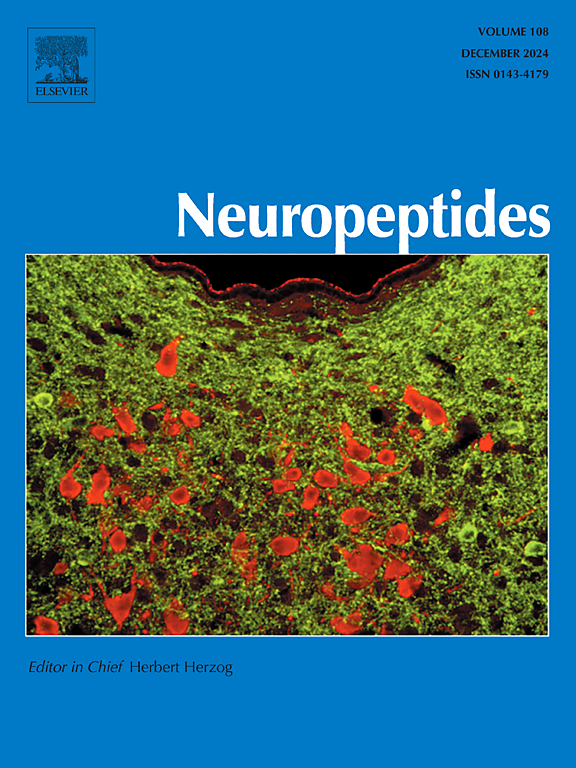生物活性肽是为阿尔茨海默病定制和设计的多能分子
IF 2.7
3区 医学
Q3 ENDOCRINOLOGY & METABOLISM
引用次数: 0
摘要
在一个日益老龄化的世界中,神经退行性疾病(NDs)呈指数级上升,研究更有效和创新的治疗方法似乎至关重要。生物活性肽(bp)作为一种具有革命性潜力的有前途的化合物出现在NDs的治疗中,特别是在阿尔茨海默病(AD)等众所周知的疾病中。这些化合物的生物学潜力主要归因于它们的药物开发优势,如增强渗透、低毒性和快速清除,以及它们的抗氧化和抗炎特性与神经保护作用生物相关,能够减轻AD的多因素病理。bp可以来自常见的饮食来源,如动物、植物、海洋,也可以来自可食用昆虫等新兴来源。然而,要分离出具有有益生物效应的活性BP,必须首先将其从母体蛋白中释放出来,然后进行合成流程。虽然计算机方法可以预测BP的潜在生物活性和结构特征,但应该进行体外、细胞和体内试验以确保这些特性。血脑屏障(BBB)微环境和健康或疾病状态下的渗透性是需要考虑的关键因素,因为它们可以限制循环治疗药物(包括bp)到达大脑的能力。本文综述了不同膳食蛋白质来源的bp的生物活性特性,并探讨了它们在AD中的有益作用和神经保护作用,揭示了新的治疗途径。本文章由计算机程序翻译,如有差异,请以英文原文为准。
Bioactive peptides as multipotent molecules bespoke and designed for Alzheimer's disease
In an increasingly aging world where neurodegenerative diseases (NDs) are exponentially rising, research into more effective and innovative treatments seems paramount. Bioactive peptides (BPs) emerge as promising compounds with revolutionary potential in the treatment of NDs, particularly in well-known conditions like Alzheimer's disease (AD). The biological potential of these compounds is primarily attributed to their drug development advantages such as enhanced penetration, low toxicity, and rapid clearance, as well as, their antioxidant, and anti-inflammatory properties bio-linked to the neuroprotective effect, able to attenuate the multifactorial pathologies of AD. BPs can be sourced from common dietary origins, like animals, plants, marine, and from emerging sources like edible insects. However, to isolate an active BP with beneficial biological effects it must first be released from its parent protein, followed by a synthesis-flow. While in silico approaches can predict a BP's potential bioactivity and structural characteristics, in vitro, cell-based, and in vivo assays should be conducted to ensure these properties. The blood-brain-barrier (BBB) microenvironment and permeability in health or disease state are key factors to consider since they can limit the ability of circulating therapeutical agents, including BPs, to reach the brain. This review focuses on the bioactivity properties of BPs from different dietary protein sources and explores their beneficial effect and neuroprotective activity in AD, unraveling new paths of treatment.
求助全文
通过发布文献求助,成功后即可免费获取论文全文。
去求助
来源期刊

Neuropeptides
医学-内分泌学与代谢
CiteScore
5.40
自引率
6.90%
发文量
55
审稿时长
>12 weeks
期刊介绍:
The aim of Neuropeptides is the rapid publication of original research and review articles, dealing with the structure, distribution, actions and functions of peptides in the central and peripheral nervous systems. The explosion of research activity in this field has led to the identification of numerous naturally occurring endogenous peptides which act as neurotransmitters, neuromodulators, or trophic factors, to mediate nervous system functions. Increasing numbers of non-peptide ligands of neuropeptide receptors have been developed, which act as agonists or antagonists in peptidergic systems.
The journal provides a unique opportunity of integrating the many disciplines involved in all neuropeptide research. The journal publishes articles on all aspects of the neuropeptide field, with particular emphasis on gene regulation of peptide expression, peptide receptor subtypes, transgenic and knockout mice with mutations in genes for neuropeptides and peptide receptors, neuroanatomy, physiology, behaviour, neurotrophic factors, preclinical drug evaluation, clinical studies, and clinical trials.
 求助内容:
求助内容: 应助结果提醒方式:
应助结果提醒方式:


